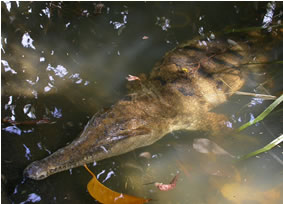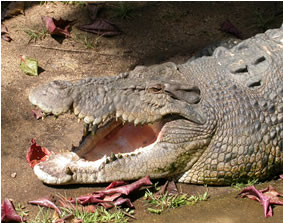

Found only in Australia.
Crocodilians
Home
Thanks to all those who have produced the photos or art work on this page.
If your work is displayed without a link to your site, please send me the link and your photo can become a link.
 |
 |
|||
| Johnston�s Crocodile (Crocodylus johnstoni) Found only in Australia. |
Estuarine Crocodile (Crocodylus porosus) |
![]()
The Crocodilians
In the Family Crocodylidae there are 8 genera, 22 species and 3 subspecies.| The family Crocodylidae is divided into 3 subfamilies: | |
| In the subfamily Crocodylinae there are 3 genera, comprising 14 animals: | ||
| In the subfamily Alligatorinae there are 4 genera, comprising 9 animals: | ||
| In this subfamily Gavialinae there is 1 genus and only 1 species: | ||
| Subfamily CROCODYLINAE | ||||||||
| Estuarine Crocodile (Crocodylus porosus) | ||||||||
| it is sometimes called the Indopacific Crocodile and in Australia it is known as the Salty or Saltwater Crocodile; however this creature can, and often does, spend its whole life in freshwater. Some people class this crocodile as endangered though the author of this site does not believe that they are endangered, lets ensure it stays this way. | ||||||||
| Johnston�s Crocodile (Crocodylus johnstoni) | ||||||||
|
or Australian Freshwater Crocodile also known as the Freshy.
Although these crocodiles are now rare in Queensland there are still plenty in WA and NT though the numbers have started to drop.
The Freshwater crocodiles are very rare in Queensland perhaps due to the cane toads and the same disaster will probably happen to those in West Australia and the Northern Territory. If the situation gets very serious perhaps the public could catch many of them from the wild before they are poisoned. If they are collected from different areas then we can have a broadly based gene pool in stock for the day when we can deal with the cane toads; though that is probably years away. The good thing is that these crocodiles live for many years. In the north they are easy to keep and there are many who would love to have a freshwater crocodile in a pond in the back yard; at no cost to the government. There are some galahs out there who say �oh no, we should not keep native animals�. Well, if the freshwater crocodiles are to die out in the wild because of the cane toads then we will be the drongos if we listen to the galahs. Remember, the fauna of Australia belongs to the citizens of Australia and no one else. It was the galahs and the government that caused the problem to begin with, so it now must be the responsible citizens that do their best to correct it. The only condition should be that the creatures are kept in comfort; that is the comfort needed to keep a happy freshwater crocodile. The minimum requirements are already known for a freshwater crocodile and, this would have to be one of the most beautiful of the crocodiles. Perhaps the giant Gould�s Goanna (Varanus gouldii) sometimes miscalled (Varanus panoptes) of northern Australia should also be caught and bred in captivity as certain clines from this gene pool are likely to go the way of the freshwater crocodile and the northern quoll. |
||||||||

|
||||||||
| New Guinea Crocodile (Crocodylus novaeguineae) | ||||||||
| a freshwater crocodile. | ||||||||
| Philippine crocodile (Crocodylus mindorensis) | ||||||||
| a freshwater crocodile from the Philippines. (CRITICALLY ENDANGERED) | ||||||||
| Siamese crocodile (Crocodylus siamensis) | ||||||||
| a freshwater species now extinct in much of its former range. On crocodile farms this crocodile is often hybridised with C porosus, which will eventually wipe out this crocodile as a species unless steps are taken to protect its integrity. (ENDANGERED) | ||||||||
| Mugger or Marsh Crocodile (Crocodylus palustris) | ||||||||
| a freshwater crocodile from the Indian Subcontinent. The skin trade is a big problem for this crocodile though the Indian government is working to protect it. | ||||||||
| Morelet�s crocodile (Crocodylus moreletii) | ||||||||
| a freshwater crocodile from Central America. | ||||||||
| Cuban crocodile (Crocodylus rhombifer) | ||||||||
| a freshwater species. If care is not taken this crocodile could be lost as a species due to hybridization with the American Crocodile C acutus. (ENDANGERED) | ||||||||
| American crocodile (Crocodylus acutus) | ||||||||
| comes from Central America and the northern end of South America. If not endangered this crocodile is most definitely vulnerable due to the skin trade of course and habitat loss. | ||||||||
| Orinoco crocodile (Crocodylus intermedius) | ||||||||
| this freshwater crocodile is now rare in Venezuela and perhaps lost from Colombia. It is in trouble because of the skin trade. (ENDANGERED) |
| The following 3 African crocodiles are all freshwater species.
The 2 smaller of these crocodiles are very vulnerable due to the skin trade. |
| Nile crocodile (Crocodylus niloticus). |
| This crocodile is the largest of the three. It is found over much of Africa including Madagascar with the exception of the southern end of the continent, the drier belt in the north west and it is absent from the Horn of Africa. Although in some of its range this crocodile is vulnerable it is not endangered, yet. |
| African Long-snouted Crocodile or Slender-snouted Crocodile (Crocodylus cataphractus). |
| Found in the rainforest areas of Central West Africa. |
| African Dwarf Crocodile (Osteolaemus tetraspis) |
| this crocodile is not of the genus Crocodylus it is found over much the same range as the Long-snouted Crocodile but extends into savanna areas where water is available. |
| Another of this group which is not of the genus Crocodylus. |
| False Gharial of Malayan Gharial (Tomistoma schlegelii) |
| There are some who believe that this animal belongs in the subfamily Gavialinae which may eventually prove correct. A very beautiful freshwater species from the Malay Peninsula, Borneo and Sumatra but by no means common and may already be lost from Thailand. As with most of the crocodilians it is being lost to the skin trade. This animal is most likely ENDANGERED in the wild. |
| Subfamily Gavialinae |
| Gharial (Gavialis gangeticus) this is a fascinating fish eating creature from the Indian subcontinent however, it is extinct from most of its former range and CRITICALLY ENDANGERED in the few places where it can now rarely be seen. |
This animal is critically endangered.
| Subfamily Alligatorinae | ||||||||||||||||||
| The next 2 are the true Alligators | ||||||||||||||||||
| American alligator (Alligator mississippiensis) | ||||||||||||||||||
| this animal is not rare and not endangered. | ||||||||||||||||||
| Chinese alligator (Alligator sinensis) | ||||||||||||||||||
| together with the Gharial this is one of the most CRITICALLY ENDANGERED of the crocodilians. | ||||||||||||||||||
|
The worlds most endangered crocodilian.
Chinese Alligator Sites |
||||||||||||||||||
| The 8 Caimans. | ||||||||||||||||||
|
All of these animals are from Central and South America. (Some are endangered because of habitat loss and the skin trade) There is still debate as to whether some of this subspecies group of the Caiman crocodilus complex should not be classified as a species in their own right. So for example if C c yacare were excepted as a species it would take the name (Caiman yacare) dropping crocodilus from its middle name. This would then mean full species status.
|
||||||||||||||||||
Crocodiles General
Some good reference books on the crocodilians:
Wildlife Management. Crocodiles and Alligators.
G. Webb, S. C. Manolis, P. Whitehead.
Published by Surrey Beatty & Son
Crocodiles and Alligators
Charles A. Ross, Dr. Stephen Garnett, Tony Pyrzakowski.
Published by Golden Press.
Alligators and Crocodiles
Malcolm Penny
Published by Crescent Books � New York
Great Creatures of the World
Alligators and Crocodiles
Published by Golden Press
Crocodiles of Australia
Graham Webb and Charlie Manolis
Published by Reed Books